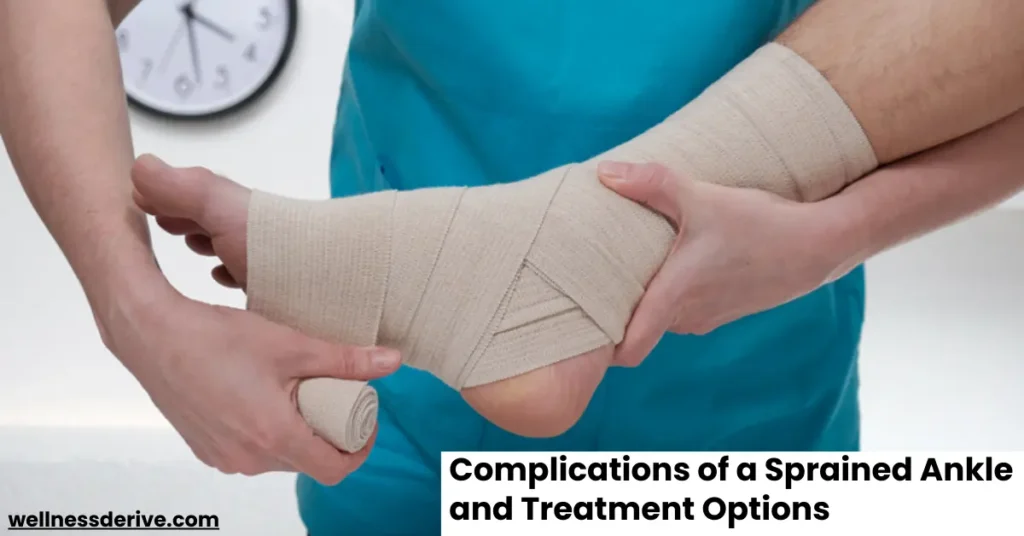A sprained ankle is a fairly common foot injury that affects thousands worldwide. You could miss a step, make an awkward movement, or land on your foot at an awkward angle to sprain your ankle. Most sprained ankles occur during sporting activities, but daily activities like walking, jogging, and wearing high heels can also cause this injury. It is a common yet highly underestimated condition that people tend to ignore until it starts to cause pain, discomfort, and mobility issues.
A sprained ankle causes ligaments to overstretch or tear. Minor damage to the ligament causes mild pain, while a ligament tear can lead to serious pain. This issue, if left untreated, can lead to serious problems that affect health and mobility.
This article discusses the symptoms and effects of a sprained ankle. You can explore different treatment options and learn how to prevent and manage a sprained ankle for quick and effective recovery. If the pain persists for more than a few days and is accompanied by swelling, bruising, or mobility issues, you should visit a foot and ankle specialist to prevent the condition from getting worse.
Symptoms of a Sprained Ankle
When the ankle twists suddenly beyond its normal range of motion, it puts pressure on the ligaments. If the pressure is too severe, it can lead to partial or complete ligament tear. Ankle sprains can range from mild (Grade I) to severe (Grade III). The most common symptoms of a sprained ankle are:
Pain
Pain is the most common and obvious symptom of a sprained ankle, ranging from mild discomfort to sharp, severe pain. The severity of pain may indicate the extent of damage to the ligaments.
Swelling
Swelling develops as the body’s inflammatory response, causing fluid to accumulate in the affected area.
Bruising
Bruising usually develops within a few hours to a day of the injury. Discoloration around the ankle is a sign of damage to the blood vessels and a severe sprain.
Tenderness
Tenderness is when you press or move the ankle a certain way and feel pain. It helps to locate the exact point of injury.
Limited Range of Motion
Stiffness, pain, or difficulty in moving the ankle limits the range of motion and indicates ligament damage.
How a Sprained Ankle Can Spiral into Bigger Issues
Ignoring a sprained ankle is a huge mistake. Some people try to walk it off, which can lead to bigger issues. Here are a few major issues that a sprained ankle can cause:
Chronic Pain
Ignoring a twisted ankle and not letting it heal completely can lead to chronic ankle instability accompanied by chronic pain. When the injury is not treated correctly, the ligament may never fully heal, causing pain.
Weakness and Instability
The ankle ligaments are responsible for stabilizing the ankle joint. When an ankle sprain doesn’t heal properly, the ankle gets weaker and gives out frequently. The instability affects balance and may cause reinjury. Each injury damages the ligament further and takes more time and effort to treat.
Joint Degeneration
The most serious consequence of an untreated sprained ankle is arthritis. Repeated stress and inflammation can affect the cartilage in the ankle joint, causing extreme pain. Arthritis is a lifelong condition that requires ongoing treatment.
The Importance of Seeking Professional Help
If you experience persistent pain, unusual bruising, swelling, and trouble bearing weight, your sprained ankle requires medical attention. You should seek the expertise of a foot and ankle specialist in Fort Worth to prevent serious long-term complications.
Correct Diagnosis and Treatment
A professional doctor conducts various physical and imaging tests to accurately diagnose your condition. You might need X-ray and MRI scans to determine the exact point and extent of damage to your ligaments. They will create a tailored treatment plan based on the type and grade of sprain. A mild sprain requires simple treatment, such as rest, compression, and elevation, whereas a ligament tear may require complex treatments and a longer recovery period.
Treatment Options
Depending on the type of sprain, doctors usually recommend the following treatment options:
- Rest, ice, compression, and elevation (RICE) for mild sprains
- Immobilization using braces, splints, and walking boots allows torn ligaments to heal
- Physical therapy to improve strength, stability, and mobility
- Medication to manage pain and inflammation
- Surgery for severe cases that cause severe pain and affect mobility and stability
Prevention of Future Injuries
Another benefit of seeking professional help is getting tips to prevent future injuries.
Proper Footwear
Wearing improper footwear is one of the major causes of foot injuries. Choose footwear based on the type of activity being performed. Running shoes provide proper cushioning against repeated impact, whereas training shoes allow for controlled movement during workouts and lateral movements. Wearing comfortable, well-fitted shoes during everyday walks and working hours protects your feet from stress and injuries. Using inserts and orthotics provides better support and alignment for your feet.
Strengthening Exercises
Your doctor or physical therapist will recommend exercises to strengthen your feet and restore your mobility. You should continue with such exercises to maintain your feet’s flexibility, strength, and range of motion. Strengthening exercises target the muscles in the calves, ankles, and feet to keep your feet strong and flexible and prevent sudden injuries.
Lifestyle Modifications
The following simple changes in your daily routine can significantly improve your foot health:
- An active lifestyle and healthy eating habits maintain a healthy body weight and reduce pressure on your feet
- Maintain an active lifestyle with walking, running, swimming, or cycling routines
- Make sure you take proper breaks and wear proper footwear while working
Balance and Proprioception Training
Some ankle injuries may occur due to a lack of balance and spatial awareness (proprioception). Training for balance and proprioception helps your body move freely in any space. Training exercises, like one-leg balancing, reverse lunges, and cone pickups, can help improve your balance and proprioception.
Gradual Return to Activities
It is vital that you follow a gradual process when resuming athletic activities. You should get approval from a professional and guidance on how to return to regular activities. Start with low-impact activities and drills that copy the movements required for your sport. Gradually increase the duration, intensity, and frequency of your exercises as your feet adapt to the movements. If you feel any pain, swelling, or discomfort, stop the activity immediately and only resume after you have fully recovered.
Physical Therapy Assistance and Career Opportunities
When dealing with complications from a sprained ankle, working with a physical therapist can significantly aid in recovery. Physical therapist assistants (PTAs) are trained to help patients regain mobility, reduce pain, and prevent future injuries through targeted exercises and rehabilitation techniques. For those interested in pursuing a career in this field, obtaining PTA education is the first step. By enrolling in accredited programs, aspiring PTAs can learn the necessary skills to assist physical therapists in various treatment settings. Additionally, many programs offer career guidance, helping students connect with potential employers and start their professional journey. Whether you’re seeking treatment for a sprained ankle or considering a career in physical therapy, PTAs play a crucial role in improving patients’ quality of life.
Managing a Sprained Ankle
Most people make the mistake of treating a sprained ankle as a minor injury. However, it is a common issue that can lead to serious ankle problems, such as chronic pain, instability, and arthritis. Early detection of a sprained ankle, immediate remedial action, and prevention measures can help prevent injuries and further damage to the foot. If you experience persistent pain or discomfort in your ankle, consult an ankle specialist to prevent serious consequences.
Disclaimer: The content on Wellness Derive is for informational purposes only and not a substitute for professional medical advice, diagnosis, or treatment. Always consult a healthcare provider for medical concerns.



